Power Mac G4
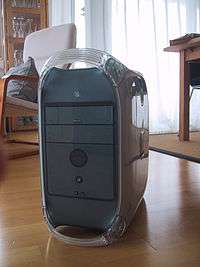 The "Graphite" Power Mac G4 | |
| Developer | Apple Computer, Inc. |
|---|---|
| Type | Mini Tower |
| Release date | August 31, 1999 (19 years ago) |
| Discontinued | June 20, 2004 |
| CPU |
single or dual PowerPC G4, 350 MHz – 1.42 GHz (Up to 2 GHz processors through 3rd-party.) |
| Predecessor | Power Macintosh G3 |
| Successor | Power Mac G5 |
The Power Mac G4 is a series of personal computers designed, manufactured, and sold by Apple Computer, Inc. from 1999 to 2004 as part of the Power Macintosh line. Built around the PowerPC G4 series of microprocessors, the Power Mac G4 was marketed by Apple as the first "personal supercomputers",[1] reaching speeds of 4 to 20 gigaFLOPS. This was the first existing Macintosh product to be officially shortened as "Mac", and is the last Mac able to boot into classic Mac OS.
The enclosure style introduced with the Power Macintosh G3 (Blue and White) was retained through its entire five year production run of the Power Mac G4, albeit with significant changes to match Apple's evolving industrial design and to accommodate increasing cooling needs. The G4 and the enclosure were retired with the introduction of the Power Mac G5.
PCI Graphics/AGP Graphics/Gigabit Ethernet
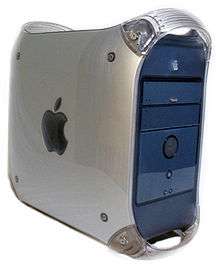
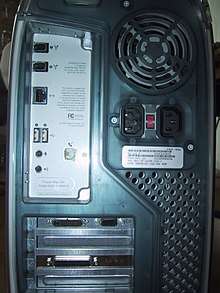
The original Power Mac G4 was introduced at the Seybold conference in San Francisco on August 31, 1999.[2] There were two variants, officially titled Power Mac G4 (AGP Graphics) with 400 MHz, 450 MHz and 500 MHz configurations available, and Power Mac G4 (PCI Graphics), with 350 MHz and 400 MHz configurations. Colloquially, this generation of Power Mac is referred to as "Graphite", owing to the colors of the case being similar to the iMac G3 Graphite.
Apple originally planned to ship the 500 MHz configuration in October 1999, but they were forced to postpone this because of poor yield of the CPUs. In response, Apple reduced the clock speed of the processor in each configuration by 50 MHz (making the options 350 MHz, 400 MHz and 450 MHz), which caused some controversy because they did not lower the original prices.[3]
The early 400 MHz (later 350 MHz) PCI-based version used a motherboard identical to the one used in Power Macintosh G3 (Blue and White) computers including the use of Zero Insertion Force (ZIF) processors sockets[4] (minus the ADB port), in a "graphite" colored case and with the new Motorola PowerPC 7400 (G4) CPU. The higher-speed models, code name "Sawtooth", used a greatly modified motherboard design with AGP 2x graphics (replacing the 66 MHz PCI slot).
The PCI variant was discontinued at the end of 1999.[5]
The machines featured DVD-ROM drives as standard. The 400 MHz and 450 MHz versions had 100 MB Zip drives as standard equipment, and as an option on the 350 MHz Sawtooth. This series had a 100 MHz system bus and four PC100 SDRAM slots for up to 2 GB of RAM (1.5 GB under Mac OS 9). The AGP Power Macs were the first to include an AirPort slot and DVI video port. The computers could house a total of three hard drives, two 128 GB ATA hard drives and up to a single 20GB SCSI hard drive, with the installation of a SCSI card.
The 500 MHz version was reintroduced on February 16, 2000, accompanied by 400 MHz and 450 MHz models. DVD-RAM and Zip drives featured on these later 450 MHz and 500 MHz versions and were an option on the 400 MHz.
The Power Mac G4 (Gigabit Ethernet) model was introduced at Macworld Expo New York on July 19, 2000; the new revision included dual-processor 450 MHz and 500 MHz versions, and a low-end single CPU 400 MHz model. It was also the first personal computer to include gigabit Ethernet as standard. Most people saw this revision as a stopgap release, because higher clocked G4s were not available; the G4’s Motorola XPC107 “Grackle” PCI/Memory controller prevented the G4 from hitting speeds higher than 500 MHz. The dual 500 MHz models featured DVD-RAM optical drive. Zip drives were optional on all models. These models also introduced Apple's proprietary Apple Display Connector video port.
| Component | Power Mac G4 (PCI Graphics) | Power Mac G4 (AGP Graphics) | Power Mac G4 (Gigabit Ethernet) |
|---|---|---|---|
| Codename | "Yikes!" | "Sawtooth, P5, Project E" | "Mystic, Medusa2, SnakeBite" |
| Model identifier | PowerMac1,2 | PowerMac3,1 | PowerMac3,3 |
| Processor | 350 or 400 MHz PowerPC G4 (7400) | 350, 400, 450 or 500 MHz PowerPC G4 (7400) | 400, Dual 450 or Dual 500 MHz PowerPC G4 (7400) |
| CPU cache | 64 KB L1, 512 KB or 1 MB backside L2 Cache per CPU (1:2) | ||
| Front side bus | 100 MHz | ||
| Memory | 64, 128, 256, 512 MB, or 1GB PC100 SDRAM Expandable to 1 GB |
64, 128, 256, 512 MB, 1 or 2GB PC100 SDRAM Expandable to 2 GB. Only 1.5 GB is seen in Mac OS 9 | |
| Graphics card | ATI Rage 128 with 16 MB of VRAM 66 MHz PCI Slot |
ATI Rage 128 or ATI Rage 128 Pro with 16 MB of VRAM AGP 2x |
ATI Rage 128 Pro with 16 MB VRAM or ATI Radeon with 32 MB of VRAM AGP 2x w/ADC Monitor support |
| Hard drive | 10 GB ATA Up to 128 GB | 10, 20, or 27 GB 7200-rpm ATA 18 or 36 GB 10K-rpm SCSI Up to 128 GB (10.4.11 and newer support hard drives larger than 128 GB with special software) | 20 GB 5400-rpm, 30 or 40 GB 7200-rpm ATA 36 or 72 GB 10K-rpm SCSI Up to 128 GB (10.4.11 and newer support Hard Drives larger than 128 GB with special software) |
| Ultra ATA/33 | Ultra ATA/66 (Optional Ultra2 LVD SCSI) | ||
| Optical drive | 32× CD-ROM or DVD-ROM | 32× CD-ROM, DVD-ROM, or DVD-RAM | DVD-ROM or DVD-RAM |
| Connectivity | 10/100BASE-T Ethernet 56k modem |
Optional AirPort 802.11b 10/100BASE-T Ethernet 56k modem |
Optional AirPort 802.11b Gigabit Ethernet 56k V.90 modem |
| Expansion | 1× Zip drive bay (optional Zip drive) 3x 64bit 33 MHz PCI slots 1× 66 MHz PCI slot (dedicated to video) |
1× Zip drive bay (optional Zip drive) 3x 64-bit 33 MHz PCI slots 1× 2× AGP slot (dedicated to video) | |
| Peripherals | 2× USB 1.1 2× FireWire 400 Built-in mono speaker Audio input mini-jack Audio output mini-jack | 2× USB 1.1 2× FireWire 400 1× Internal FireWire 400 Built-in mono speaker Audio input mini-jack Audio output mini-jack | 2× USB 1.1 2× FireWire 400 Built-in mono speaker Audio input mini-jack Audio output mini-jack |
| Maximum Operating System | Mac OS X 10.4.11 "Tiger" and Mac OS 9.2.2 | Mac OS X 10.4.11 "Tiger" and Mac OS 9.2.2 Unofficially can support 10.5 Leopard via 3rd party software | |
| Weight | 13 kg (28.7 pounds) | 13.6 kg (30 pounds) | 13.6 kg (30 pounds) |
Digital Audio/Quicksilver
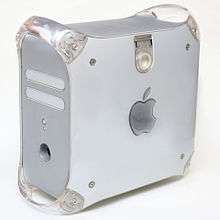
A new line with a revamped motherboard but the familiar "Graphite" case debuted on January 9, 2001. Known officially as the Power Mac G4 (Digital Audio), it is in effect a Quicksilver design inside the Graphite enclosure. Motorola had added a seventh pipeline stage in the new PowerPC G4 design to achieve faster clock frequencies. New features included a fourth PCI slot, a 133 MHz system bus, an improved 4X AGP slot, and a new "digital audio" Tripath Class T amplifier sound system. The models were offered in 466 MHz, 533 MHz, dual 533 MHz, 667 MHz and 733 MHz configurations, the latter two using a newer PowerPC 7450 processor. The number of RAM slots was reduced to three, accommodating up to 1.5 Gigabytes of PC133 SDRAM.
The 733 MHz model was the first Macintosh to include a built-in DVD-R or Apple-branded SuperDrive, the rest of the line became the first Macs to ship with CD-RW drives. This was also the first series of Macs to include an Nvidia graphics card, the GeForce 2MX.
At Macworld Expo New York on July 18, 2001, a new line debuted featuring a cosmetically redesigned case known as Quicksilver, and various upgrades to the specifications. It was available in 733 MHz, 867 MHz and dual 800 MHz configurations. The 733 MHz model was notable for not having a level three cache. The SuperDrive was offered on the mid-range 867 MHz model, and UltraATA/100 hard drives were offered on all models. The internal speaker received an upgrade, using a Harman/Kardon speaker.
Quicksilver received criticism in MacWorld's review for removing the "eject" button and the manual eject pinhole, as well as the pass-through monitor power plug, and for the base specification of 128 MB RAM as being insufficient for running Mac OS X.[6]
Updated Quicksilver machines, officially named Power Mac G4 (QuickSilver 2002), were introduced on January 28, 2002 with 800 MHz, 933 MHz and dual 1 GHz configurations. This was the first Mac to reach 1 GHz. Again, the low end 800 MHz model did not include any level three cache. The graphics in this series were provided by an Nvidia GeForce4 MX400 card. Some of these models have ATA controllers with 48 bit LBA for hard drives larger than 128 GB.
| Component | Power Mac G4 (Digital Audio) | Power Mac G4 (Quicksilver) | Power Mac G4 (Quicksilver 2002) | Power Mac G4 (Quicksilver 2002ED) |
|---|---|---|---|---|
| Codename | "Tangent, Clockwork" | "Titan, Nichrome" | N/A | N/A |
| Model identifier | PowerMac3,4 | PowerMac3,5 | ||
| Processor | 466, 533, Dual 533, 667, or 733 MHz PowerPC G4 (7400/7410/7450) | 733, 867, or Dual 800 MHz PowerPC G4 (7450) | 733 (education only), 800, 933 MHz, or Dual 1 GHz PowerPC G4 (7450/7455) | 867 MHz PowerPC G4 (7455) |
| CPU cache | 64 KB L1, 256 KB (1:1) or 1 MB (1:2) L2, 1 MB L3 (733 MHz) | 64 KB L1, 256 KB (1:1) L2, 2 MB L3 (867/Dual 800 MHz) | 64 KB L1, 256 KB (1:1) L2, 2 MB DDR L3 (933/Dual 1 GHz) | 64 KB L1, 256 KB (1:1) L2 |
| Front side bus | 133 MHz | |||
| Memory | 128, 256, or 512 MB PC133 SDRAM Expandable to 1.5 GB | |||
| Graphics | ATI Rage 128 Pro with 16 MB VRAM, ATI Radeon or Nvidia GeForce2 MX with 32 MB VRAM, GeForce3 with 64 MB VRAM | Nvidia GeForce2 MX with 32 MB VRAM, Geforce2 MX with TwinView or Geforce3 with 64 MB VRAM | ATI Radeon 7500 with 32 MB VRAM, Nvidia GeForce4 MX with 64 MB VRAM or GeForce4 Ti with 128 MB VRAM | Nvidia GeForce4 MX with 32 MB VRAM |
| Hard drive | 30 GB 5400-rpm, 40 or 60 GB 7200-rpm ATA 36 or 72 GB SCSI Up to 128 GB | 40 GB 5400-rpm, 60 or 80 GB 7200-rpm ATA 36 or 72 GB SCSI Up to 128 GB | 40, 60, or 80 GB 7200-rpm ATA 36 or 72 GB SCSI Supports Hard Drives larger than 128 GB | 40 GB 7200-rpm Supports Hard Drives larger than 128 GB |
| Ultra ATA/66 (Optional Ultra SCSI or Ultra 160 SCSI) | ||||
| Optical drive | CD-RW or DVD-ROM or DVD-R/CD-RW SuperDrive (on 733 MHz model only) | CD-RW or CD-RW/DVD-ROM Combo Drive or DVD-R/CD-RW SuperDrive (867 and dual-800 models only) | CD-RW | |
| Connectivity | Optional AirPort 802.11b Gigabit Ethernet 56k V.90 modem | |||
| Expansion | 1x Zip Drive bay (Optional 250 MB Zip Drive) 4x 64-bit 33 MHz PCI slots 1x 4x AGP slot (dedicated to video) | |||
| Peripherals | 2x USB 1.1 2x Firewire 400 Built-in mono speaker Audio output mini-jack Apple Pro Speakers mini-jack | |||
| Maximum Operating System | Mac OS X 10.4.11 "Tiger" and Mac OS 9.2.2 | Mac OS X 10.4.11 “Tiger” and Mac OS 9.2.2 (733 and Dual 800 MHz) | Mac OS X 10.4.11 “Tiger” and Mac OS 9.2.2 (733 and 800 MHz) | Mac OS X 10.5.8 "Leopard" |
| Mac OS X 10.5.8 “Leopard” (867 MHz) | Mac OS X 10.5.8 “Leopard” (933 MHz and Dual 1 GHz) | |||
| Weight | 13.6 kg (30 Pounds) | |||
Mirrored Drive Doors/FW800
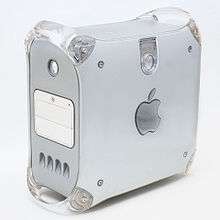
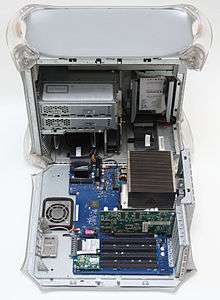
Another generation of Apple Power Mac G4s, officially named "Mirrored Drive Doors" (MDD), was introduced on August 13, 2002, featuring both a new Xserve-derived DDR motherboard architecture and a new case design. All models were available in dual processor configurations running at 867 MHz, 1 GHz or 1.25 GHz. As with the Xserves, the PowerPC 7455 CPU used does not have a DDR frontside bus, meaning the CPU could only use at most 50% of the new system's theoretical memory bandwidth, providing no improvement over previous models. The rest was available to the graphics card and I/O systems. A single processor 1.25 GHz model would be the last Power Mac G4 the company offered to the public after the announcement of the new Power Mac G5, introduced in June 2003.
The last real update to the Power Mac G4 line was on January 28, 2003 offering dual 1.42 GHz PowerPC 7455 processors, with features not seen in previous DDR models: built-in FireWire 800 connector, optional integrated Bluetooth, and optional integrated AirPort Extreme. These were also the first Power Macs that could not boot into Mac OS 9.
With the launch of the Power Mac G5 on June 23, 2003, Apple re-introduced the August 2002 Power Mac G4 because of perceived demand for Mac OS 9 machines. Between that, its low price-tag, and the delayed availability of Power Mac G5s, it proved a strong seller for a relatively short time. Production stopped on June 27, 2004 and the remaining inventory was liquidated, ending the 20-year legacy of Classic Mac OS support with its discontinuation.
Noise issues
A limited range of serial numbers of this model was noted for a noisy fan, earning them the unofficial designation "Windtunnel G4" in some communities. Noise complaints became such a problem that Apple later replaced the machine's power supply (PSU) and primary cooling fan with quieter versions, and initiated a voluntary do-it-yourself (DIY) replacement scheme for all previously sold machines. A very common issue in the MDD models was a failing PSU.
It is believed[7] that the reason for the problem is a bug in the CPU with handling cache coherency in dual cpu setups when switching the CPU to low power states.[8] To address this problem, Apple released a firmware update, disabling switching to low power states.
In a low power state, each CPU would have only consumed about 5 Watts[9] (or even less when switching to even lower power states), making for 10 Watts needing to be cooled. But when run in full power mode (as to circumvent the cache problem), each CPU does consume about 50 Watts making for a total of 100 Watts[10]—essentially the upper limit for which the cooling system was designed, making the fans run at full speed, even when the machine is mostly idle.
The machine can be configured to use only a single CPU at the Open Firmware prompt.[11] There was also a developer utility[12] to switch between single and dual CPU via a System Preferences preference pane.[13] Using that API, a tool was developed[14] to switch to single CPU on low load, enabling the low power mode and switching to dual CPU mode only when required. Soon after suggesting that hack to Apple, a new firmware was released,[15] disabling the API for switching between single and dual CPU modes.[16]
At least some MDD models also have a design flaw resulting in noise in the audio-out, picking up interference from the mouse, graphics card, hard drive and other hardware. According to Apple, this is a ground loop issue, and only occurs when used with professional balanced signal audio equipment,[17] however some audio experts contended it is due to shielding defects on the motherboard and affects all equipment.[18]
| Component | Power Mac G4 (Mirrored Drive Doors) | Power Mac G4 (Mirrored Drive Doors FW800) | Power Mac G4 (Mirrored Drive Doors 2003) |
|---|---|---|---|
| Codename | "P57" | "P58" | N/A |
| Model identifier | PowerMac3,6 | ||
| Model Number (Order Number) | M8570 (M8787LL/A, M8689LL/A, M8573LL/A) | M8570 (M8839LL/A, M8840LL/A, M8841LL/A) | M8570 (M9145LL/A), M9309
(M9145LL/A) is a re-released version of (M8573LL/A) |
| Processor | Dual 867 MHz, Dual 1 GHz, or Dual 1.25 GHz PowerPC G4 (7455) | 1 GHz, Dual 1.25 GHz or Dual 1.42 GHz PowerPC G4 (7455) | Dual 1.25 GHz or Dual 1.42 GHz PowerPC G4 (7455/7455B) |
| CPU cache | 64 KB L1, 256 KB L2, 1 MB or 2 MB DDR L3 | ||
| Front side bus | 133 MHz (867 MHz DP) | 133 MHz (1 GHz) | 167 MHz |
| 167 MHz (1 GHz DP+) | 167 MHz (1.25 GHz DP+) | ||
| Memory | 256, 512 MB PC-2100 (Dual 867 MHz), or PC-2700 (Dual 1+ GHz) DDR SDRAM Expandable to 2 GB (4 x 512 MB PC-3200 DDR SDRAM) |
256, 512 MB PC-2100 (1 GHz), or PC-2700 (Dual 1.25+ GHz) DDR SDRAM Expandable to 2 GB (4 x 512 MB PC-3200 DDR SDRAM) |
256, 512 MB PC-2700 DDR SDRAM Expandable to 2 GB (4 x 512 MB PC-3200 DDR SDRAM) |
| Graphics Card | Nvidia GeForce4 MX with 32 MB VRAM, ATI Radeon 9000 Pro with 64 MB VRAM, or GeForce4 Ti with 128 MB VRAM Upgradeable to Nvidia GeForce 7800 GS with 256 MB VRAM (last GPU supported) |
Nvidia GeForce4 MX or ATI Radeon 9000 Pro with 64 MB VRAM, GeForce4 Ti or Radeon 9700 Pro with 128 MB VRAM Upgradeable to Nvidia GeForce 7800 GS with 256 MB VRAM (last GPU supported) |
ATI Radeon 9000 Pro with 64 MB VRAM or Nvidia GeForce4 Ti 128 MB Upgradeable to Nvidia GeForce 7800 GS with 256 MB VRAM (last GPU supported) |
| Hard drive | 60, 80, or 120 GB 7200-rpm ATA 36 or 72 GB Ultra 160 SCSI Supports Hard Drives larger than 128 GB | 60, 80, or 120 GB 7200-rpm ATA Supports Hard Drives larger than 128 GB | 80 or 160 GB 7200-rpm ATA Supports Hard Drives larger than 128 GB |
| Ultra ATA/133 (2) and Ultra ATA/66 (2) (Optional Ultra SCSI or Ultra 160 SCSI) | Ultra ATA/133 (2) and Ultra ATA/66 (2) (Optional Ultra SCSI) | Ultra ATA/133 (2) and Ultra ATA/66 (2) | |
| Optical drive | CD-RW/DVD-ROM Combo Drive or DVD-R/CD-RW SuperDrive (Optional additional Combo Drive) | ||
| Connectivity | Optional AirPort 802.11b Gigabit Ethernet 56k V.92 modem | Optional AirPort Extreme 802.11b/g Gigabit Ethernet 56k V.92 modem Optional Bluetooth 1.1 | Optional Airport 802.11b Gigabit Ethernet 56k V.92 modem |
| Peripherals | 2x USB 1.1 2x Firewire 400 Built-in mono speaker Audio input mini-jack Audio output mini-jack Apple Pro Speakers mini-jack | 2x USB 1.1 2x Firewire 400 1x Firewire 800 Built-in mono speaker Audio input mini-jack Audio output mini-jack Apple Pro Speakers mini-jack | 2x USB 1.1 2x Firewire 400 Built-in mono speaker Audio input mini-jack Audio output mini-jack Apple Pro Speakers mini-jack |
| Expansion | 4x 64-bit 66 MHz PCI-X slots 1x 4x 133 mHz AGP slot (dedicated to video) | ||
| Maximum Operating System | Mac OS X 10.5.8 "Leopard" | ||
| Mac OS 9.2.2 supported natively and Mac OS 9.1 or higher in the Classic Environment | Mac OS 9.1 or higher supported solely in the Classic Environment | Mac OS 9.2.2 supported natively and Mac OS 9.1 or higher in the Classic Environment (final model to support Classic Mac OS natively) | |
| Weight | 19.1 kg (42 lbs) | ||
Timeline of Power Macintosh models
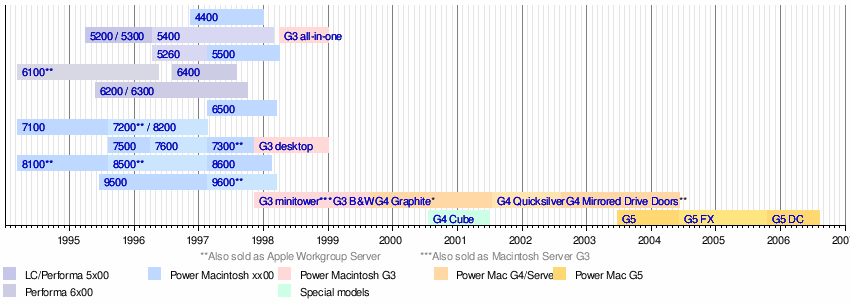
See also
| Wikimedia Commons has media related to Power Mac G4. |
Notes
- ↑ "Apple Unveils `Personal Supercomputer'". SFGate.
- ↑ "Apple steps up to G4 Macs". ZDNet.
- ↑ "The 400 MHz PowerMac Reviewed". The Mac Observer. February 21, 2000. Retrieved October 19, 2008.
- ↑ "The Apple Power Macintosh G4 400MHz PCI". Forevermac.com. Retrieved November 30, 2011.
- ↑ "Power Mac G4 (PCI Graphics) - Technical Specifications".
- ↑ "Hands on with the Power Mac G4/867". MacWorld. 2001-08-25.
- ↑ by me after having done a lot of research and experiments on this topic at that time
- ↑ There is a Motorola errata for this
- ↑ please add a reference to the Motorola spec here
- ↑ this is reflected in the overall power consumption of the machine in measurements
- ↑ add a link to the description how to do this: described somewhere in the apple developer docs
- ↑ part of the CHUD tools, add ref to this tool here
- ↑ intended to debug software problems that would occur when running multiple threads on a machine offering real concurrency)
- ↑ by me
- ↑ add reference to that firmware here
- ↑ this might have been related to the failing power supplies. Switching the load on the power supply may have let to transients that shortened the PSU's life
- ↑ apple.com
- ↑ www.sweetwater.com